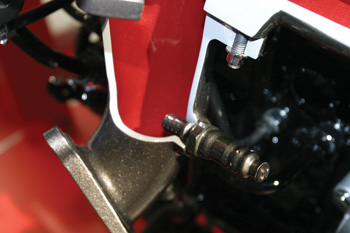Oxygen sensors are a key component in the engine management system and for emissions control. The oxygen sensors provide a rich/lean signal to the powertrain control module (PCM) that indicates the balance of the air/fuel mixture. This vital bit of information is absolutely essential for good fuel economy, performance and emissions.
 “Downstream” oxygen sensors located in or just behind the catalytic converters also are used to monitor the efficiency of the catalyst, and to assist with long-term fuel trim.
“Downstream” oxygen sensors located in or just behind the catalytic converters also are used to monitor the efficiency of the catalyst, and to assist with long-term fuel trim.
Oxygen sensor problems are a common cause of poor fuel economy as well as emission test failures. A bad oxygen sensor will typically generate lower-than-normal voltage output, and be slow to respond to rapid changes in the air/fuel mixture. This will often result in a richer-than-normal fuel mixture, which causes an increase in fuel consumption and higher tailpipe emissions.
A bad oxygen sensor also may prevent the OBD II catalyst monitor from running. This can happen if a vehicle has a bad upstream or downstream O2 sensor. If the catalyst monitor doesn’t run because of a bad O2 sensor, the vehicle will be rejected for an OBD II plug-in emissions test — and it won’t be accepted until the problem has been diagnosed and repaired.
In recent years, the early-style ceramic thimble O2 sensors have been mostly replaced by ones that have a flat ceramic strip inside the tip. They work the same, but the newer “planar” O2 sensors warm up faster, respond more quickly to changes in the air/fuel mixture, and typically have a longer service life. Both “universal” and “exact replacement” versions are available for most applications.
Air/Fuel sensors (also called “wide band” O2 sensors) work differently than traditional zirconia O2 sensors. They include an “oxygen pump” and “nerst cell” that allow the sensor to provide a much more exact reading of the actual air/fuel ratio, not just a rich or lean indication as is the case with a traditional O2 sensor. Instead of generating a voltage signal, an A/F sensor modulates a reference signal from the PCM. The current signal from the A/F sensor can travel in one of two directions (positive or negative), and it gradually increases in the positive direction as the air/fuel mixture becomes leaner. At the “stoichiometric” or “lambda” point when the air/fuel mixture is perfectly balanced (14.7 to 1), the current flow in the A/F sensor circuit stops and there is no current flow in either direction. When the air/fuel ratio becomes progressively richer, the current reverses direction and gradually increases in the negative direction in proportion to the actual air/fuel ratio.
Like ordinary thimble and planar O2 sensors, A/F sensors also have an internal heater circuit to help them reach and maintain the required internal operating temperature. A/F sensors typically operate at a higher temperature: 1,292 to 1,472 degrees F versus about 450 to 600 degrees F for ordinary O2 sensors. Consequently, if the heater circuit fails, the A/F sensor may not produce a reliable signal. This will usually set a fault code and turn on the Check Engine light.
Note: The presence of an O2 sensor heater circuit code does not always mean the sensor needs to be replaced. The fault might be in the external sensor wiring, connector or heater control circuit.
O2 sensor problems are one of the leading causes of emission test failures. What’s more, a bad O2 sensor (upstream or downstream) will prevent the OBD II catalyst monitor from running — which is also grounds for rejecting a vehicle for a plug-in OBD II test. The OBD II system needs good signals from both the upstream O2 or A/F sensors and downstream O2 sensors to keep tabs on the operating efficiency of the converter.
It’s important to make sure a bad A/F sensor has been correctly diagnosed because the price of these sensors is usually several times more than that of a conventional O2 sensor.




